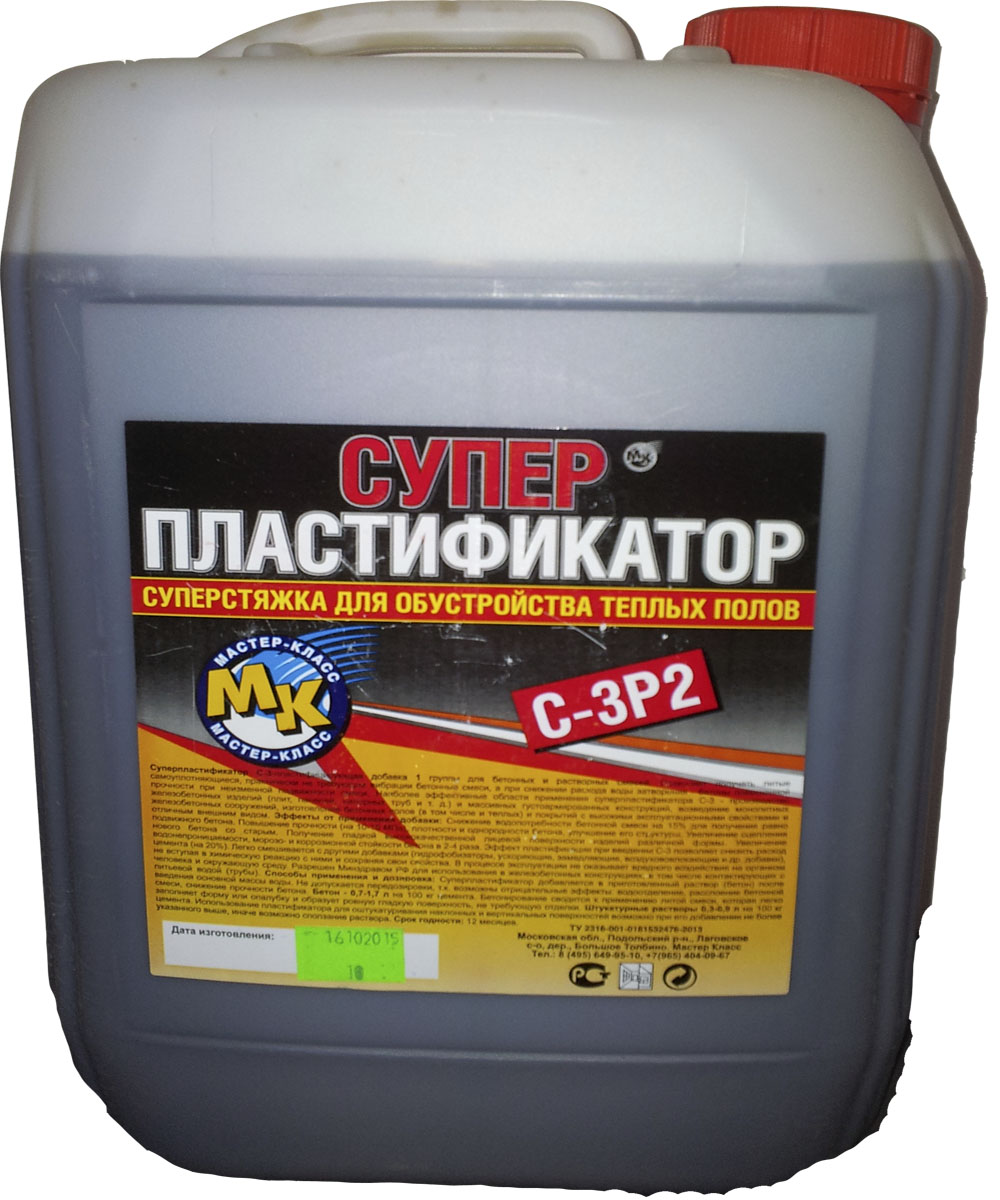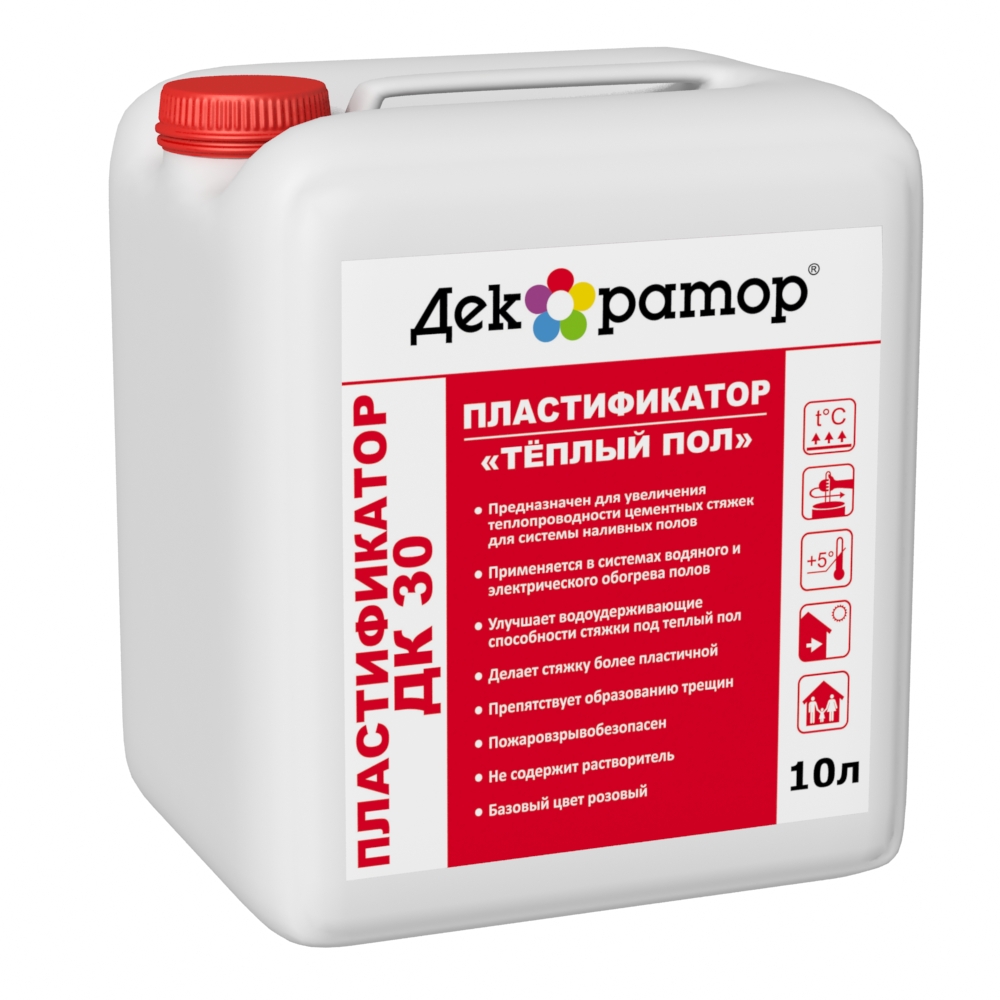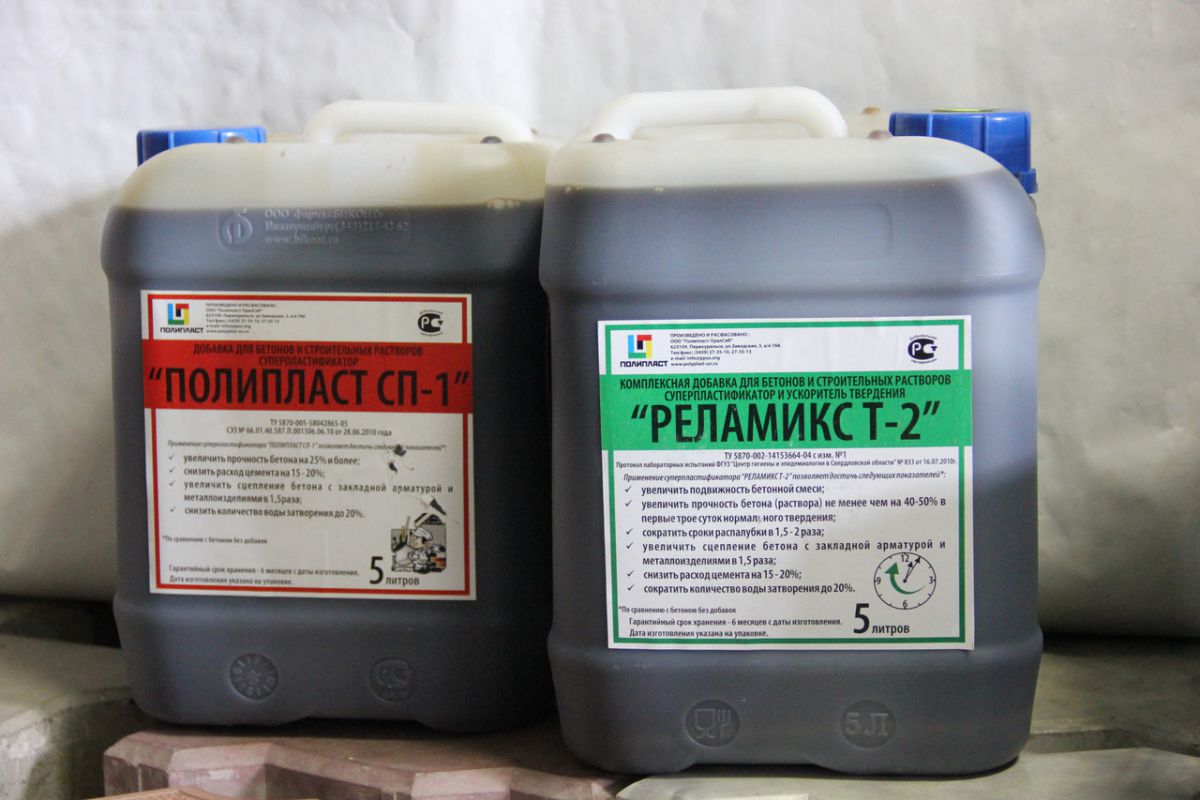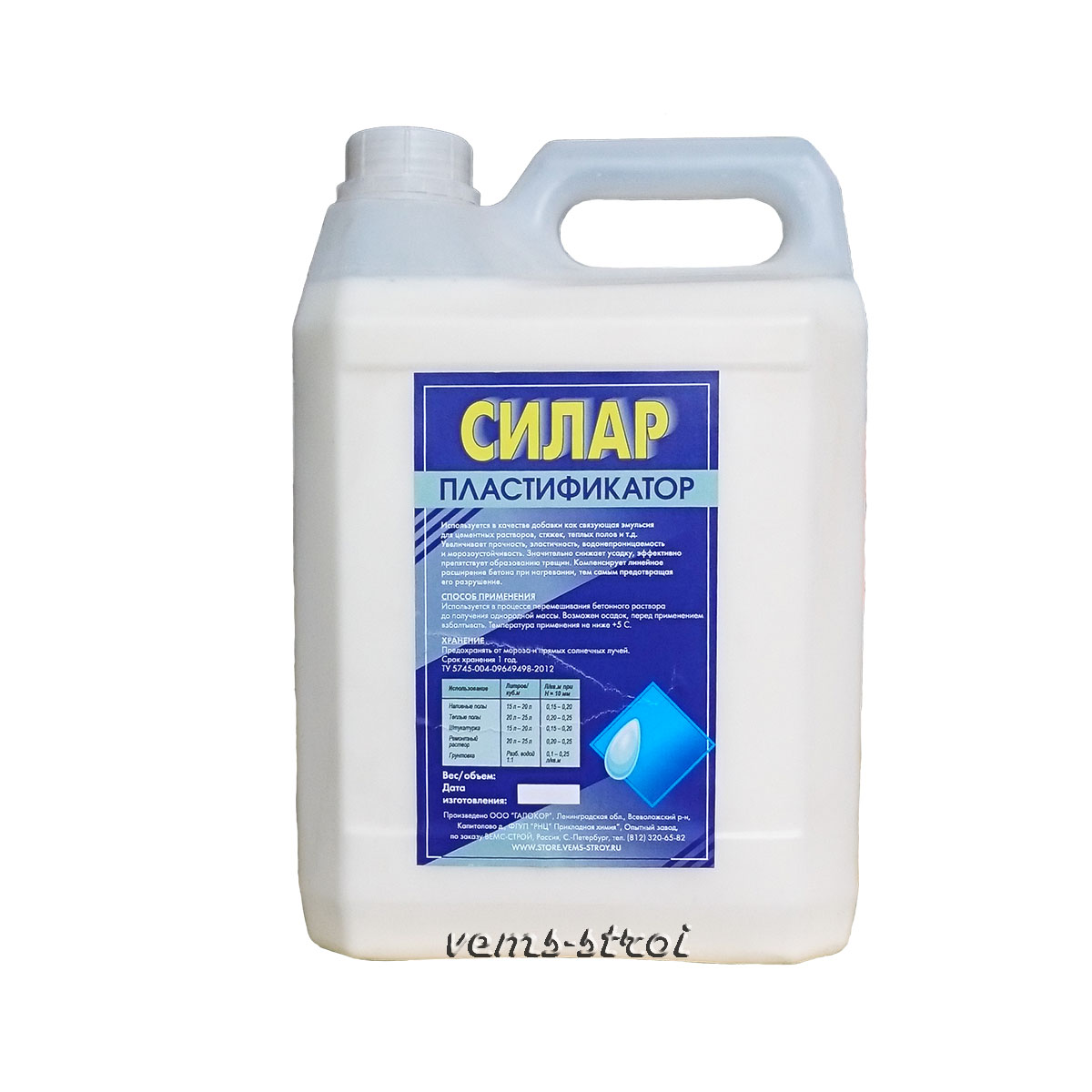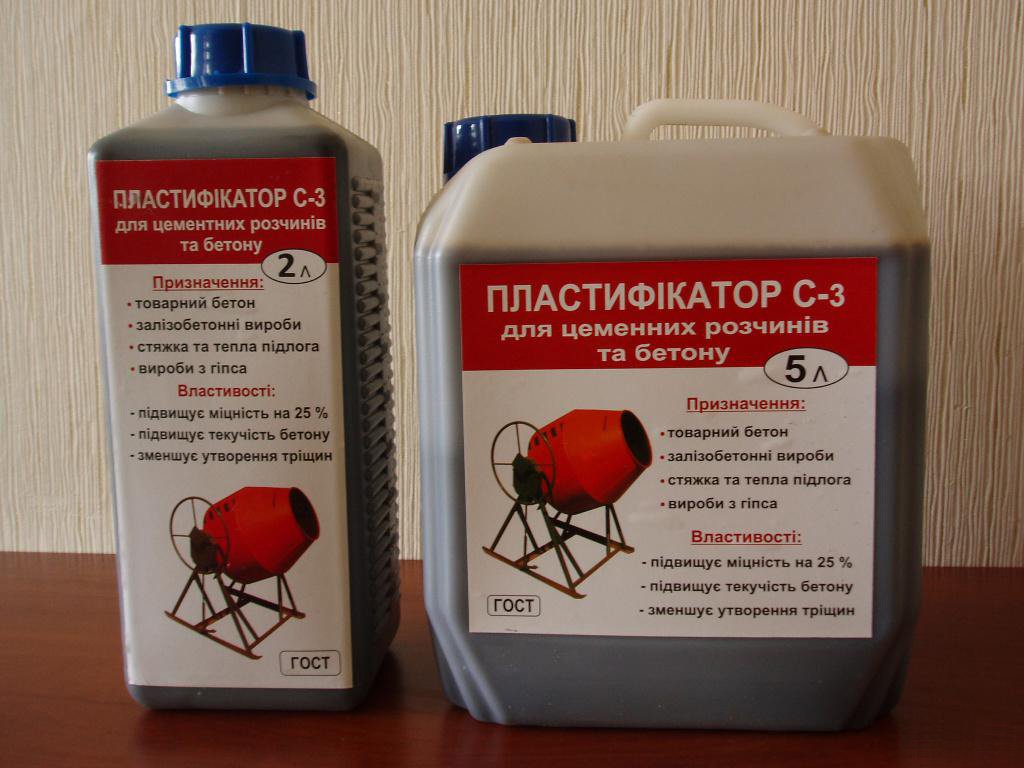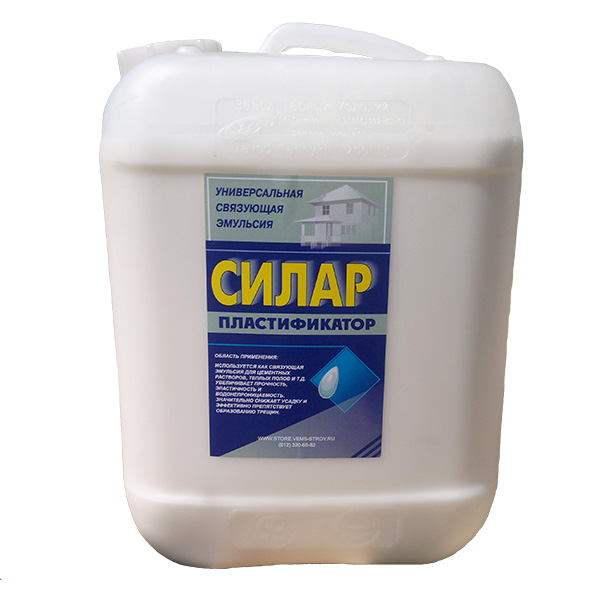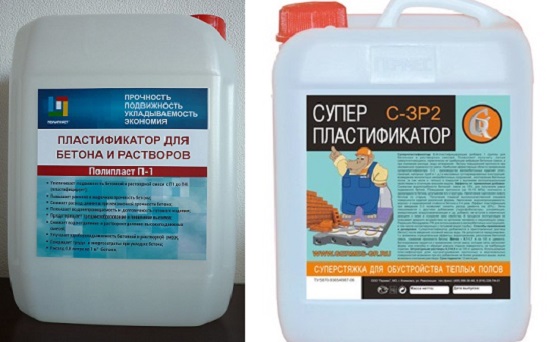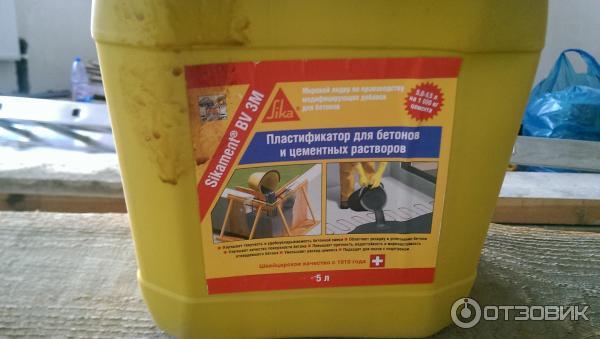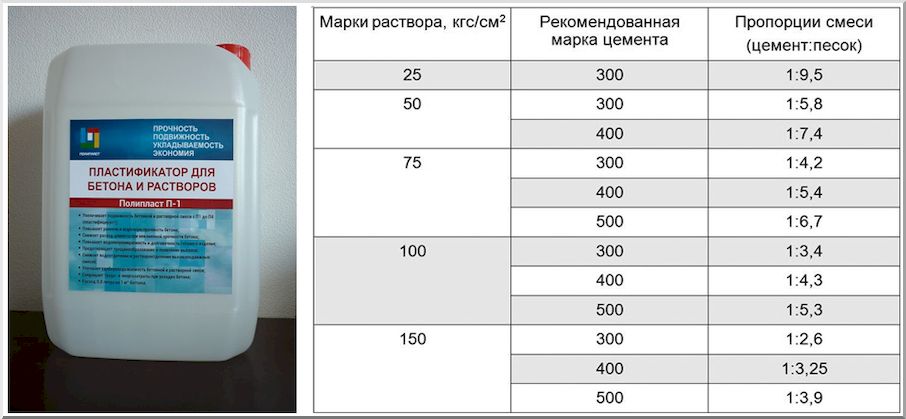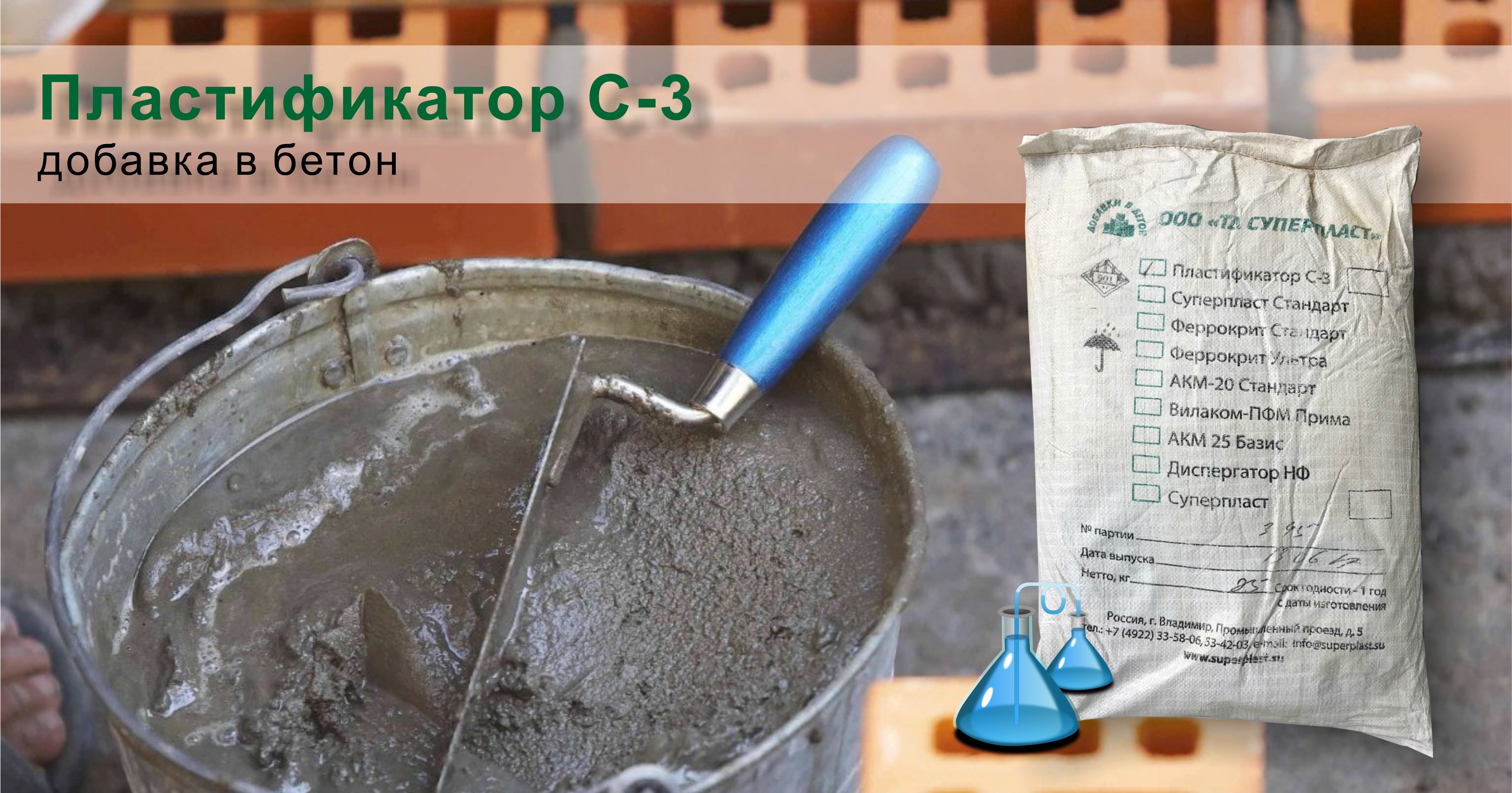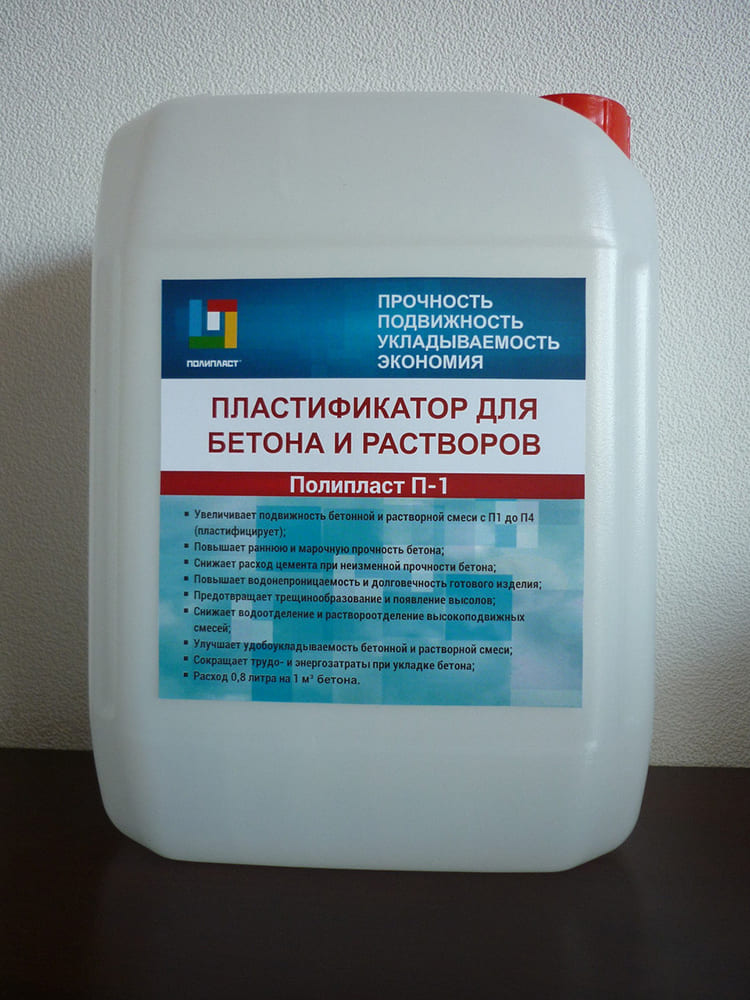Method for preparing concrete mixture with liquid plasticizer S-3
- The plasticizer solution is thoroughly mixed in the packaging container.
- The liquid additive is measured in the calculation:
- 0.5–1 l per 100 kg of cement for mobile concrete used in the construction of walls, ceilings, floor screeds;
- 1-2 liters per 100 kg of cement for self-compacting concretes, which are used when pouring foundations, molds for monolithic and complex reinforced concrete load-bearing structures.
- A plasticizer is added to the water to dissolve.
- Water with a plasticizer is poured into a working concrete mixer.
- The required amount of cement is measured and loaded into a concrete mixer.
- Add solid aggregate and bring the solution to readiness.
The more plasticizer you add to the original mixture, the longer it will take for the concrete to harden.
Method of application of dry plasticizer S-3:
The dry plasticizer is a polydisperse brown powder that is added to the starting material in the form of an aqueous solution with a concentration of 15 to 35%. The powdered plasticizer is delivered to the construction site in plastic bags from 0.8 to 25 kg.
To mix concrete based on powdered plasticizer S-3, you must:
- Prepare a 35% aqueous solution of the plasticizer.
- According to the passport or certificate of the plasticizer, its moisture content is determined. The standard moisture content of the powder additive is 4.6%.
-
According to TU5745-001-97474489-2007 "Recommendations for the use of the complex additive" Plasticizer S-3 "for the preparation of 1 kg of 35% solution, 366 g of powder and 634 g of water are required.
- Calculate the amount of mortar for the concrete mix.
- If the required concentration of the plasticizer in the initial mixture is 0.5% in terms of an absolutely dry additive, that is, 0.5 kg per 100 kg of cement, then the consumption of a 35% plasticizer solution will be equal to: 0.5 * 100/35 = 1.43 kg.
-
In liters, this value will be: 1.43 / 1.192 = 1.2 liters per 100 kg of cement, where 1.192 is the density of a 35% plasticizer solution (table 4 TU5745-001-97474489-2007).
- Add the plasticizer solution to the water before pouring it into the concrete mixer.
- Add cement and solid aggregate with constant stirring.
- Bring the mixture to readiness for styling.
Advice. To prepare a solution of a plasticizer from a dry powder, use the dosage indicated on the manufacturer's packaging: two parts of water are added to one part of the powder.
To obtain a homogeneous plasticizer solution, the powder is diluted in warm water and infused for several hours.
Application area
Superplasticizer S-3 is a universal additive that makes it possible to change the properties of the concrete mixture and control the process of its laying and hardening.
Adding a plasticizer allows you to:
- increase the mobility of the concrete mixture, which can be easily laid without the formation of voids and hardens evenly without cracks and surface irregularities;
- to reduce the amount of water in the cement slurry, which increases the strength of concrete by 20–25% while maintaining the mobility of the concrete mixture;
- save up to 22% of cement without changing the strength of concrete and the mobility of the initial solution;
- to increase the density and, accordingly, the water resistance of concrete due to the reduced water content in the mixture;
- to increase the adhesion (adhesion) of the cement mixture with metal reinforcement and solid fillers;
- reduce labor costs and time spent on pouring concrete;
- eliminate or significantly reduce vibration for compacting concrete mix.
Due to the ratio of the increased mobility of the initial mixture and the final strength of concrete obtained on the basis of a superplasticizer, it is used in the manufacture of:
- monolithic building structures made of high strength heavy concrete;
- reinforced concrete pipes and structures made of high strength heavy concrete;
- densely reinforced supporting structures for bridge supports and high-rise structures;
- reinforced concrete structures of complex configuration with narrow formwork;
- monolithic slabs and panels in civil engineering, requiring special strength and homogeneity of the concrete mixture;
- foundations and monolithic structures using concrete pumps and concrete pumps;
- Reinforced concrete products on an industrial scale, which reduces the residence time of structures in heat chambers, and increases production volumes.
Features of use

Plasticizer S-3 is perfectly combined with other types of concrete additives. This indicates that it can be used in tandem with many anti-freeze additives, as well as substances that accelerate or, conversely, retard hardening.
Plasticizer C-3 should not be used in an amount that exceeds, in terms of dry matter, 0.3-0.8% relative to the weight of the cement mixed in the solution. The additive must be introduced after diluting it in water.
If you add a plasticizer in the amount of 0.2-0.7% of the cement content, then you can create cast mixtures that compact themselves and almost do not need the vibration process, while if you reduce the volume of water, concrete will gain increased strength, and the mobility will remain unchanged ... It is permissible to use both described methods in part in the work, that is, to make a solution of increased mobility compared to the initial one and at the same time to increase the strength characteristics of the mixture, reducing the volume of water used.
The choice of plasticizer
Each plasticizer has its own characteristics that allow it to be used in special operating conditions.
So, when pouring a screed on a water floor, it is important to avoid the formation of air bubbles in the screed.
Manufacturers offer formulations specially designed for underfloor heating
When installing an electric underfloor heating, a semi-dry fill is chosen as the preferred option. The mortar is created on the basis of sand, cement with the addition, a plasticizer, fiberglass and a small amount of water - this will exclude the appearance of cracks in the finished screed.
For a floor with an electric heat carrier, a dry mixture is chosen, and for a structure with a water one - a liquid composition
Therefore, it is important to familiarize yourself with the labeling on the packaging with the plasticizer, where its characteristics are indicated.
Electric floor heating cake
Varieties of plasticizer
There are several types of plasticizer that are most often used in screed construction.
Table 1. Varieties of plasticizers
| Image | Description | Average cost, as of September 2020 |
|
HLV-75 |
A universal composition that is used for both water and electric underfloor heating. For 100 kg of cement, 0.5 to 2 liters of mortar will be required. At the same time, water demand decreases by 30%, and the strength of the screed increases by 25%. The screed hardening process increases by 3 times. | 560 |
|
SP-1 S-3 |
As a percentage of the mass of cement, the additive is from 0.2 to 0.7%. When applied, the fluidity of the solution increases by 6-9 times. At the same time, the water demand of cement decreases by 15%, and the strength of the screed increases by 30%. The corrosion resistance of the screed is increased by 3 times. | 350 |
|
Batichem |
Universal additive for warm floors. The water demand of the solution decreases by 20%, the shrinkage of the solution decreases and its final strength increases. | 450 |
|
Rehau |
High quality powdery composition from a German manufacturer. It not only increases the elasticity of the solution, but also differs in environmental friendliness and fire-fighting properties. When using this powder, the thermal conductivity of the screed and its strength are increased. | 2800 |
|
Sanopol |
Liquid material is used to increase the stability of the screed against mechanical damage. | 1400 |
|
ArmMix |
A liquid composition of Russian production, which makes the concrete screed waterproof and frost-resistant, which allows work to be carried out at negative temperatures. | 450 |
The plasticizer comes in the form of a powder or a dark brown liquid. For the floor screed, the C-3 superplasticizer is usually chosen. It is quite simple to work with it - it is enough to observe the proportion of adding the composition (from 0.3 to 0.8 liters per 100 kg of solution).
Plasticizers, specially developed for warm water floors, provide, due to the compaction of the solution, a tighter adhesion to the heating pipes and increase the heat transfer of the screed by 20%.
The plasticizing composition can be:
- Liquid. Convenient to use, as it does not require additional preparation.
- Dry. Convenient in that it has a long shelf life. It is brought to a working consistency by diluting with water.
- Reinforcing. It contains additional inclusions that strengthen the screed.
- Anti-freeze. It is used for outdoor work.
Plasticizer Additives
Algorithm for preparing modification
It is recommended to carry out preparation for masonry or other intended purposes, using building materials that meet standard standards. When mixing, it is better to make adjustments empirically, achieving a ligament. Experimentation and mixing time depends on the requirements of the process.
Creating a homogeneous mass based on the modifier, you need to conduct a kind of research:
- it is better to make the connection for testing in a separate container;
- taking into account the execution of the scheduled tasks, you need to know a certain amount of adding the diluted modifier.

In this way, the hardening time can be calculated and the required amount of additive can be determined. The system for determining the required volume of dry impurity is similar to the above actions, it is better to conduct a small experiment and be completely confident in the correct selection. It is necessary to dilute the additive, find out the hardening time, starting from the type of construction tasks. The main process leading to the hardening of the bond and its transformation into cement stone is hydration, in which anhydrous clinker minerals (C2S and C3S) form calcium hydro-silicates, as a result of which the cement glue begins to thicken, set and harden. The stone will gain the final strength of the fortress only after 3 - 5 years. You can use the ready-made ratio indicated in the instructions, this is one to two.
Professional craftsmen try to accurately calculate the rate with the utmost attention to quality. Modern innovative additives increase the required characteristics
Excellent results can be achieved with the correct ratios. As a result, it is possible to get as close as possible to the ideal water-cement ratio, significantly increasing the strength, water resistance, fluidity while maintaining a satisfactory ratio of the quality and price of the material. Hence the conclusion: the rejection of the classification today looks unreasonable from both financial and technical points of view.
Antifreeze additives, their functions and composition
Up to 10% water is added to the concrete solution, depending on the purpose for which the solution is used - for brickwork, foundation or pouring the floor screed.
The hardening of the concrete solution is significantly slowed down with decreasing temperature. If the temperature reaches minus indicators, even not very low (- 3-5 ° C), the water in the solution begins to freeze. As a result, concrete practically ceases to harden. Instead, it just freezes. When defrosting, it still hardens, but becomes loose and significantly loses its strength characteristics.
To preserve the possibility of concrete gaining strength, it is necessary to ensure the presence of a liquid component in it. Anti-freeze additives help this.
There are a number of plasticizer additives on the market for concrete mortars. They improve the dispersion of the solid components of the solution. This means that the friability of cement, sand, gravel and the transformation of the solution into suspension increases. In this case, the resistance of the solution to freezing increases to -15 ° C, and the process of hardening of the concrete solution is also accelerated.
Antifreeze additives (antifreeze), plasticizers are produced both by domestic enterprises and foreign firms. Of the Russian products, one can name Relamix, Polyplast and others. There are also many Chinese-made products on the market.
The problem with anti-freeze additives in most cases is that they contain chlorides that corrode the reinforcement parts. For example, when laying a foundation or screed with a reinforcing mesh.
Concrete components
Paving slabs are used in rather difficult conditions. It must be durable, highly resistant to various manifestations of the external environment and abrasion. Therefore, special requirements are imposed on the raw materials used. Traditionally, the composition of the concrete mix for sidewalk coverage includes cement, sand, crushed stone or gravel, water and additives, in particular plasticizers. The quality and properties of the final product largely depend on the technical characteristics of these materials. Let's talk about each component of the molding sand in more detail.
Cement as a base
The main task of cement is to bind all the components for the manufacture of paving stones into a single solid mass. There are many types of this material, but the most widespread are Portland cement and Portland slag cement. Both options are suitable for the manufacture of paving stones and paving slabs. Moreover, when choosing, you should focus on one manufacturer and it is better to buy cement from one batch. Then you will not have to deal with adjusting the composition, since different batches of goods or products from different factories may differ slightly in individual indicators, even if the brand is the same.
What are plasticizers for?
Some types of cement are endowed with the property of uneven volume change during hardening. As a result, there are cracks on the surface of the paving slabs. This quality can manifest itself in the case of an incorrect calculation of the water-cement ratio. So the plasticizer will help reduce water consumption, while improving the plasticity of the concrete mixture and adding greater strength to the finished product. And:
- increase the density of the pavement;
- rid the surface of products from the appearance of white stains;
- keep the color cast;
- make the work surface smooth, without cavities and cracks, since the high porosity of the tile makes it vulnerable to atmospheric manifestations.
Sand and crushed stone
Placeholders must be clean. The main danger for concrete in the production of paving slabs, emanating from sand, is the increased content of clay and silt impurities. The regulatory tolerance is no more than 5% of the total weight.
It is recommended to use crushed stone or gravel of a medium fraction with a grain diameter of 10-20 mm, belonging to the high-strength category. These requirements are met by the material obtained from the processing of granite rocks.
Water
As for the water, it must be clean, free of impurities and impurities. It is undesirable to use cold water, it needs to be slightly warmed up. Then, in combination with the use of a plasticizer, it is easier to make the solution more mobile. Average room temperature is optimal.
Advantages of adding S-3 plasticizer

What does the addition of a plasticizer affect, what characteristics of the concrete mix change.
- The fluidity of the concrete solution increases by a factor of five or more. Mobility increases from P1 to P5.
- The weight of the applied cement is reduced up to 17%.
- The volume of mixed water is reduced to 20%.
- The structure of the concrete mix is improved, thereby reducing the time spent vibrating the material to remove air.
- The strength of the finished product is increased.
- The surface of the concrete structure becomes smooth.
- The adhesion between the mortar and the embedded products, the reinforcing frame, increases.
- If the concrete is properly diluted with a plasticizer and other additives are added to the finished mass, then you can end up with a frost-resistant, moisture-proof and crack-resistant mixture.
All these characteristics and properties lead to the fact that the production costs for the production of concrete itself and for the manufacture of products and building structures from it are reduced. Moreover, even the simplest cement mortars with the addition of a plasticizer make it possible to use them in the most critical building structures.
How to do it yourself: recipe for preparing a solution, consumption
Let's take a closer look at the entire manufacturing process. It assumes the following procedure:
- Before placing the molds on a flat surface, they must be treated with a solution of hydrochloric acid, the concentration of which is 6–8%. You can use a special lubricant for this purpose. Then the finished product will fall out of shape perfectly. For self-lubrication, it is necessary to take a suspension of used engine oil and water in a ratio of 1: 3.
- After preparing the molds, you can proceed to the preparation of the plasticizer and dye solution. It is forbidden to add these components to a dry solution. First, they are diluted with warm water in the correct proportion. If the amount of the solution used is 40 liters, then the consumption of the plasticizer is 200 g, the cement dye is 60 g. The dry components are diluted in a liter of warm water.
- For the production of paving slabs, you received a concrete solution, which includes a bucket of cement and 2 buckets of filler. Before starting mixing, moisten the mixer pear with water. For further preparation of concrete, observing the proportions, it is necessary: to place cement and filler in a concrete mixer; put a liter of diluted pigment and plasticizer in a bucket, add 4 liters of water; mix cement and filler dry, and then add ½ bucket of prepared water. To achieve the best tile performance, it is necessary to supplement the mortar with soft reinforcement. It can be purchased at any hardware store. The amount of fiberglass is 2 large handfuls.
- The kneading must be thorough so that no lumps form. The end product should be heavy and dry, so try to pay more attention to the mixing process.

You may also be interested in schemas laying paving slabs.
Top plasticizer manufacturers
When choosing a brand of plasticizer, you should pay attention to whether it is suitable for installing a warm floor. Information about this is indicated on the packaging of the goods.
The cost of additives is also an important parameter. There are many manufacturers who produce plasticizer for warm floors. Let's dwell on some of them, which are considered the most popular.
Sanpol
It is a liquid mixture that meets all user requirements for product quality. Increases the strength of the finished screed and increases its thermal insulation properties.
When using it, water consumption is reduced by 10-15%.
Pouring the screed is a rather complicated and time-consuming process that requires some building skills. However, the addition of this brand leads to a longer setting of the mixture, which makes it possible to correct some of the inaccuracies of the screed.
ArmMix
It is the aqueous composition of the plasticizer. It is used for pouring floors and making dense, waterproof concrete. Produced by the leading Russian firm "Thermoplast".
It might be interesting
The advantages of this mixture include:
- reduces cement consumption;
- provides high density of concrete mix;
- the ability to use at subzero temperatures;
- reduces deformation of the screed during concrete shrinkage;
- increases the plasticity of the solution.
The composition is poured into water and mixed in a separate container or added from the package directly to the finished sand-cement mortar.
Warm floor HLV-75
The main purpose of this plasticizer is the installation of underfloor heating.
The main advantages of using it:
- an increase in the mobility and thermal conductivity of the concrete mixture, respectively, by 50 and 30 percent.
- protection against cracking;
- reduction of cement consumption by about 20%
- corrosion protection of reinforcement.
The plasticizer for underfloor heating screed of this brand is suitable for its common types: electric and water.
It is added directly to the concrete mixture with stirring or to water before preparing the composition.
The solution should be thoroughly mixed so that the modifier dissolves evenly in the concrete.
Rehau
Materials of this brand are added to the solution when installing especially thin screeds for a warm floor. This additive belongs to premium products.
The addition of Rehau plasticizer significantly improves the physical properties of the concrete screed, and increases its thermal conductivity and strength.
The use of this additive reduces the likelihood of possible cracking. This is due to the optimal proportions of cement and water in the production of concrete mix.
The product is sold in a container with a volume of 10 kg.
Superplasticizer S-3
The ready-made modifier С-3 has the form of a viscous cream-colored liquid. It is packaged in metal cans and plastic containers with a volume of 0.5 to 10 liters.
Used in the manufacture of concrete mortar together with cement, water and solid aggregates.
The advantages of using this additive:
- increases the mobility of the concrete solution, which reduces the possibility of cracking when it solidifies;
- increases the strength of the composition by about 25%;
- allows you to save 20-22% of cement and reduce the proportion of water in the mixture;
- improves the adhesion of the mortar to the surface and metal structures.
When using the additive in the form of a dry powder, it must first be diluted in warm water and left for several hours to obtain a homogeneous mixture. When diluting, use the proportion: one part of powder to two parts of water.
How to make a plasticizer for concrete with your own hands
Stimulates the defenses of the immune system and warms up after a long walk in the cold. Drink tea with ginger if you suddenly wet your feet, get frozen or after a cold, ARVI, flu.
4. Cinnamon. It normalizes blood sugar, so it is good to drink sweets and bread and cheese with tea with cinnamon.
5. Tea with mint. It will help you fall asleep and wake up with restored strength, as it has the ability to calm the nerves, relieve stress.
Spicy and delicious, mild tonic drink
Take: half teaspoon. ground or finely chopped fresh ginger root, a pinch of ground cardamom, 1 cinnamon stick, a pinch of nutmeg and 1 tablespoon of dry mint leaves (you can replace 1 bunch with fresh ones), 2 cloves.
Pour all this with boiling water and cook over low heat for 4 minutes, strain.
And this tea is ideal to drink in the morning, it is very refreshing, tones, improves blood circulation.
Put in a teapot (in a tea infuser): a pinch of cardamom, 0.5 tsp of cinnamon and the same amount of grated ginger.
Fill in with a glass of boiling water, close the lid and leave for 5 minutes. Ideally combined with a spoonful of honey with a bite.
This tea is good to drink in the middle of the day, after lunch. Especially if it was very heavy.
Add to the brewed tea: 1/3 tsp each anise, coriander and cumin seeds. Close and leave for 5 minutes.
Classic ginger tea
Ginger tea has a warming and tonic effect.Improves blood circulation, lymph outflow, enhances digestion. It removes metabolic products from the body.
For 1 liter of water you need to take: 3 tablespoons of fresh finely grated ginger, a pinch of ground black pepper, 6 tablespoons of sugar, 4 tablespoons of orange juice, mint leaves.
Add ginger and sugar to the boiled water, as soon as it dissolves, filter the tea. Put pepper and add juice, mint leaves. Serve hot.
Masala tea
This tea replenishes energy very well, helps with a breakdown, drowsiness, sluggish digestion.
Star anise star Three cloves 2 allspice peas 2 cm fresh ginger root ¼ teaspoon nutmeg Pinch of cinnamon 0.5 teaspoon ground cardamom Sugar to taste Water and milk
Boil a glass of milk, add spices and sugar to it. Leave on for 5 minutes. Brew strong black tea. Add milk in a ratio of 2 parts milk to 1 part tea. You can add a vanilla pod.
Delicious tea for you!
Benefits and main features:
Additional components have long been appreciated in the construction industry, new buildings of residential complexes or industrial buildings cannot do without an innovative additional tool, which:
- contribute to the economy of cement, reducing the consumption coefficient;
- make the bond much stronger, up to 25 percent;
- improve resistance to temperature changes, the modified composition does not lose its consistency;
- relieve from additional application of moisture and drying frequency;
- allow you to apply the solution without using vibration;
- construction work in the winter can not be suspended until more acceptable weather conditions;
- increase the elasticity and preservation of the original appearance, during the required period of work, without adding a certain amount of liquid.
The emergence of innovative additives made it possible to use concrete pumps, without them it would have been impossible to fill the densely reinforced formwork. Monolithic new buildings would remain too expensive, and modern megacities might simply not appear. The positive aspects are overshadowed by one drawback, it is a slowdown in drying and contraction.
For some, this aspect is not essential, for others it is an important feature. This nuance can be avoided with the help of a special additive, which eliminates the effect of slow hardening, completely normalizes the normal drying process.
Varieties and features of characteristics
Due to a wide variety of tools, the quality of new structures cannot be better, but for proper use you need to know what a plasticizer is for concrete, which is divided into certain groups:
- modifiers - maintain the mobility of the mixture during the entire operation, several times. Excellent frost resistance, corrosion resistance.
- accelerators - in a couple of days they can increase strength, regardless of the brand of cement used.
- mixture to increase frost resistance - used in the construction industry during cold weather. The solution does not freeze at low temperatures.
- super-plasticizers - they are introduced during the transportation of concrete slurry in the heat, while the mobility remains the same, the water resistance and elasticity increase. The use of a suspension has a beneficial effect on budget savings, it is profitable, practical and expedient.
- air-entraining - reproduces the porosity of the material, creating small balloons that are evenly distributed throughout the volume. The masonry is then strong, does not break. The microstructure is much more frost-resistant and reproduces the heat-insulating effect.
- additives with the specificity of self-sealing - are used when pouring reinforced structures, adhesion to metal reinforcement increases, due to which durability is achieved.
Available plasticizer replacement options
When preparing plasticizing components for concrete on your own, you must pay attention to the following points:
- ecological purity of the modifier, which should not adversely affect human health;
- resistance to interaction with the components contained in the cement slurry;
- preservation of the properties of the additive, which should not volatilize during cement hydration;
- use temperature appropriate to the actual conditions on the jobsite.

The simplest way to improve the properties of the masonry composition is to add liquid soap or washing powder.
You can prepare plasticizing additives for cement mortar yourself, using various substances used in everyday life:
- slaked lime;
- powder for washing;
- dish detergent;
- shampoo or liquid soap;
- PVA glue;
- egg white.
When adding a plasticizer to a solution on your own, observe the following recommendations:
- lime should be mixed with concrete in equal proportions for indoor work. When performing outdoor activities, slaked lime should be one fifth of the mass of Portland cement. The introduction of lime improves the plasticity of the solution, as well as its bactericidal properties;
- washing powder used as a modifier should be diluted with water. It is found in the amount of 100–150 g per 50 kg of cement. The introduction of washing powder allows the prepared solution to be transported for a long time, due to the slowing down of the hydration of the cement;
- ordinary shampoo or soap in a liquid state is introduced at the mixing stage in a volume of 200 g per bag of cement. The additives extend the hardening of the solution by 4–5 hours, which is convenient when performing increased volumes of concrete work;
polyvinyl acetate based glue is also added to the concrete mortar. By adding 200 g of adhesive to a bucket of mortar, it is possible to increase the resistance of concrete to penetrating moisture.
When trying to save money and when using household plasticizers, certain problems arise:
- the appearance of salt streaks on the surface of the concrete;
- increased shrinkage of dense composition;
- intensive foaming when mixing with a mixer.
Advantages and disadvantages
The additive improves the rheological properties of the cement slurry, as well as its physical and mechanical properties. It is compatible with most types of concrete improvers - hardening accelerators, frost resistance additives and other additives.
C-3 increases the curing time of the solution. On the one hand, this property is considered an advantage in situations where it is necessary to deliver ready-mixed concrete to remote construction sites. On the other hand, this is a disadvantage, since due to the increase in the duration of curing, the pace of construction is reduced.

Other advantages include:
- budgetary cost;
- increasing the convenience of working with concrete - the mass does not stick to forms and is easily mixed;
- obtaining concrete with a higher strength class;
- low consumption (for each ton of the binder component, from 1 to 7 kg of powdered plasticizer or from 5 to 20 liters of a liquid additive per 1 ton of solution is required).
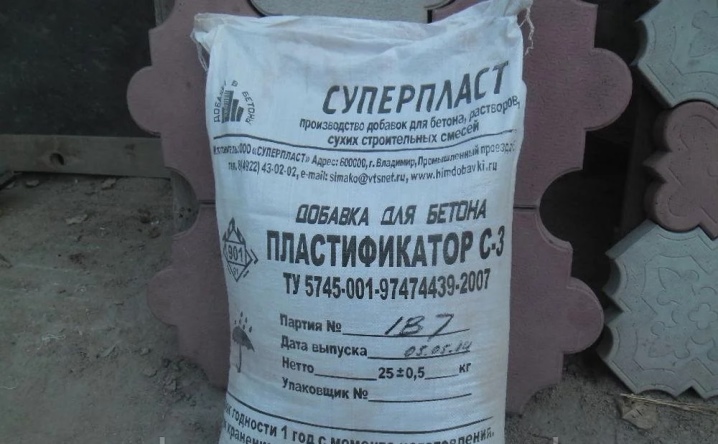
Thanks to the use of the S-3 plasticizer, one can resort to the mechanized method of pouring concrete mass, save the amount of cement, and exclude the use of vibration compaction equipment.



